Evaluating Sources / Fact-checking / Media Bias /
> Digital Citizenship
SIFT: the four moves - The Research Hub - Research Guides at Southwestern University. The Future of Fake News. Adler presents a few new tools that seem pretty innocuous and even cool at first look. But when you think about how they might be used to spread misinformation, the ethical implications are concerning. Voco, an Adobe application still in development, promises to become “the Photoshop for speech.”
National News Literacy Week — Presented by News Literacy Project & Scripps. Media Bias/Fact Check - Search and Learn the Bias of News Media. Media Education Lab. Filter bubble. Template:Direct1 The term was coined by internet activist Eli Pariser circa 2010 (Technology such as social media) “lets you go off with like-minded people, so you're not mixing and sharing and understanding other points of view ...

It's super important. It's turned out to be more of a problem than I, or many others, would have expected.” Concept[edit] Social media, seeking to please users, can shunt information that they guess their users will like hearing, but inadvertently isolate what they know into their own filter bubbles, according to Pariser. This process is not random, as it operates under a three-step process, per Pariser, who states, "First, you figure out who people are and what they like. According to one Wall Street Journal study, the top fifty Internet sites, from CNN to Yahoo to MSN, install an average of 64 data-laden cookies and personal tracking beacons each.
Why is Fake News Created? - Fake News - Research Guides at Madison College (Madison Area Technical College)
Welcome to the Spot the Troll Disinformation Quiz. Factitious. Bad News. The News Literacy Project. MediaWise: How to sort fact from fiction online. The Sift: Bloomberg tests social media rules. Bad News. Jessica Kirkland sur Twitter : "My 11th graders are in “news groups” right now. Instead of discussing a book, they’re each tracking 5 common topics across a variety of news publications, then meeting weekly to discuss how their coverage differed in terms. Fact Checking Historical Claims Online.
Evaluating Sources. RADAR Framework - Evaluating Sources: Using the RADAR Framework - LibGuides at Loyola Marymount University. Fake News - LibGuides at William Paterson University. The Cardigan Papers – American history and news literacy meet in the school library,
Not all scientific studies are created equal - David H.
"A popular study from the 1970s that helps sell millions of dollars' worth of fish oil supplements worldwide is deeply flawed, according to a new study being published in the Canadian Journal of Cardiology.
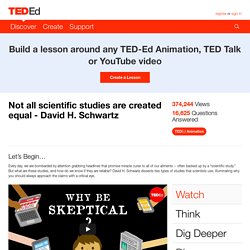
The original study, by Danish physicians H.O. Bang and D.J. Dyerburg, claimed Inuit in Greenland had low rates of heart disease because of their diet, which is rich in fish oil and omega-3 fatty acids from eating fish and blubber from whales and seals.
"
How false news can spread - Noah Tavlin. YALSA Teen Literacies Toolkit. Download the print version (PDF) or view the web version.

Created by the Literacies Toolkit Resource Retreat Participants August 2017 About the Kit In this toolkit, we use the “fake news” phenomenon as an approach to addressing multiple literacies. We re-examine and discuss culturally-inclusive literacies strategies library staff can use with teens to help them make sense of their world and build a robust set of skills as they prepare to enter college or start careers. YALSA would like to thank Hailley Fargo, Kristin Fontichiaro, Jennifer Luetkemeyer, Trent McLees, Renee McGrath, Allison Renner, and Julie Stivers for participating in the creation of this toolkit.
How to Spot Fake News: Lesson Plan for Grades 9-12. A Rough Guide to Spotting Bad Science. A Rough Guide to Spotting Bad Science Click to enlarge A brief detour from chemistry, branching out into science in general today.
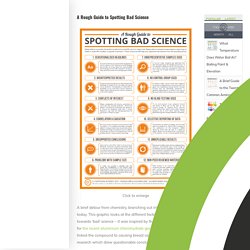
This graphic looks at the different factors that can contribute towards ‘bad’ science – it was inspired by the research I carried out for the recent aluminium chlorohydrate graphic, where many articles linked the compound to causing breast cancer, referencing scientific research which drew questionable conclusions from their results. The vast majority of people will get their science news from online news site articles, and rarely delve into the research that the article is based on.
A Rough Guide to Types of Scientific Evidence. Click to enlarge Today’s graphic looks at science in general, rather than just chemistry.

It’s in a similar vein to the Rough Guide to Spotting Bad Science posted last year, but this time looking at the hierarchy of different types of scientific evidence. You might think science is science, but some evidence is ranked higher in the scientific community than others, and having an awareness of this can help you sort the science from the pseudoscience when it comes to various internet claims.
This graphic was inspired by a couple of things this week. The first was the recent Gawker article on the Food Babe’s spurious chemical claims, which you may well have seen spreading like wildfire through social media earlier this week. There’ll be more on aspartame in a future post, but what I took away from this was that some people out there aren’t sure what counts as robust scientific evidence.
Generally, scientific studies often fall into two main categories: observational and experimental.
Choose Your News: A Media Literacy HyperDoc - Google Slides. Five Editor-Approved Tips for Media Literacy in Any Class. In 2015, a year before murmurs of “fake news” became omnipresent, textbook publisher McGraw-Hill was under fire for a World Geography book illustration.
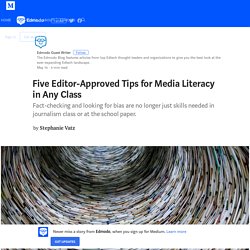
The section, on patterns of immigration throughout American history, referred to a wave of “immigration” in which African “workers” arrived in the United States. Parents, students and teachers were outraged by the sugarcoated and outright false history of slavery being shared in classrooms across Texas. This was one incident of false information making its way into schools, but it was far from the first or last. Clickbait headlines and polarizing politics have made it a daunting challenge for teachers to find factual, reliable information inside and outside of the classroom. A class needs to share a foundation of truth. Fact-checking and looking for bias are no longer just skills needed in journalism class or at the school paper.
Civic Online Reasoning. If young people are not prepared to critically evaluate the information that bombards them online, they are apt to be duped by false claims and misleading arguments. To help teachers address these critical skills, we’ve developed assessments of civic online reasoning—the ability to judge the credibility of digital information about social and political issues.
These assessments ask students to reason about online content. We’ve designed paper-and-pencil tasks as well as tasks that students complete online. These assessments are intended for flexible classroom use. We hope teachers use the tasks to design classroom activities, as the basis for discussions about digital content, and as formative assessments to learn more about students’ progress as they learn to evaluate online information. As part of MediaWise, the Stanford History Education Group is developing and evaluating new civic online reasoning lesson plans for middle and high school students.
Beyond Fake News. Fake News Historical Timeline (Common Sense Education)
Factitious. EdCan Network Facts on Education Fake News 1. Facing Facts: An Inside Look At Facebook's Fight Against Misinformation. Truth Decay. News & Media Literacy. First Draft. FAIR. NewseumED. Are your students savvy searchers? Can they spot the difference between a straight news article and an opinion piece? Do they recognize bias in their sources … or in themselves? You are in one of Fact Finder: Your Foolproof Guide to Media Literacy’s 11 flexible, multimedia lesson plans to tackle these challenges.
Eight skill-building lesson plans introduce essential media literacy concepts through engaging explainer videos and colorful infographics that help students revisit, retain and apply the key concepts. The accompanying News or Noise?
Truth, truthiness, triangulation: A news literacy toolkit for a “post-truth” world. We were guaranteed a free press, We were not guaranteed a neutral or a true press.
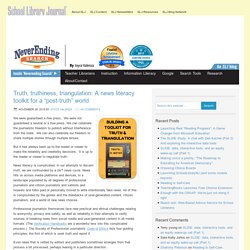
We can celebrate the journalistic freedom to publish without interference from the state.
Deepfake videos: This is why educators need to ...
How To Spot Fake News. Critical thinking is a key skill in media and information literacy, and the mission of libraries is to educate and advocate its importance. Discussions about fake news has led to a new focus on media literacy more broadly, and the role of libraries and other education institutions in providing this. When Oxford Dictionaries announced post-truth was Word of the Year 2016, we as librarians realise action is needed to educate and advocate for critical thinking – a crucial skill when navigating the information society.
Bias News - Evaluating News - LibGuides at University of South Carolina Upstate.
Hyperpartisan - Websites, Facebook Pages, and Social Media Accounts These are websites, social media pages, or accounts designed to spread information presented through a highly partisan, biased lens.

Media Bias Ratings AllSides. Verification Handbook: homepage. Media Bias/Fact Check - Search and Learn the Bias of News Media. Fact-Check It: Digital Tools to Verify Everything Online - Poynter. Over the past few years, misinformation has exploded online.
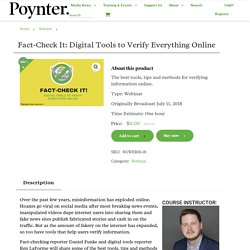
Hoaxes go viral on social media after most breaking news events, manipulated videos dupe internet users into sharing them and fake news sites publish fabricated stories and cash in on the traffic. But as the amount of fakery on the internet has expanded, so too have tools that help users verify information. Fact-checking reporter Daniel Funke and digital tools reporter Ren LaForme will share some of the best tools, tips and methods for verifying information online.
Evaluate: Assessing Your Research Process and Findings – The Information Literacy User’s Guide: An Open, Online Textbook. Introduction In 2010, a textbook being used in fourth grade classrooms in Virginia became big news for all the wrong reasons.
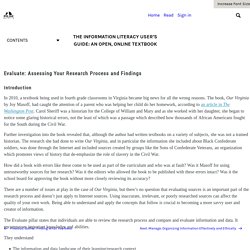
The book, Our Virginia by Joy Masoff, had caught the attention of a parent who was helping her child do her homework, according to an article in The Washington Post. Carol Sheriff was a historian for the College of William and Mary and as she worked with her daughter, she began to notice some glaring historical errors, not the least of which was a passage which described how thousands of African Americans fought for the South during the Civil War. Further investigation into the book revealed that, although the author had written textbooks on a variety of subjects, she was not a trained historian.
RADAR Framework - Evaluating Sources: Using the RADAR Framework - LibGuides at Loyola Marymount University.










